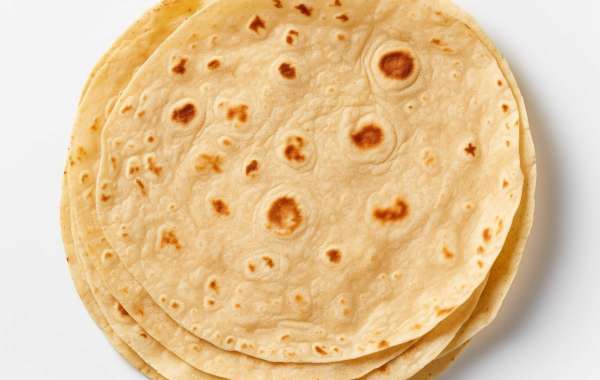As we become increasingly conscious about our health and well-being, we are constantly on the lookout for healthier food options. One such option is gluten-free bread. Gluten is a protein found in wheat, barley, and rye, and can cause digestive problems for some people. Gluten-free bread is a great alternative for those who are sensitive to gluten or have celiac disease.
Indian cuisine is known for its diverse range of bread, from naan to roti and paratha. However, many of these breads are made with wheat flour, which contains gluten. As the global demand for healthier and diverse foods grows, many people are turning to online platforms to easily access ingredients that were once hard to find locally. This has made it easier for enthusiasts and chefs alike to experiment and innovate with traditional recipes, creating versions like gluten-free Indian breads using alternative flours such as jowar, bajra, and rice flour.
Fortunately, there are several gluten-free Indian bread options available that are just as delicious and nutritious
Understanding Gluten
Gluten is a protein found in grains such as wheat, barley, and rye. It is what gives bread its chewy texture and helps it rise. However, for some people, consuming gluten can cause health problems.
Celiac disease is an autoimmune disorder that affects about 1% of the population. When people with celiac disease consume gluten, their immune system attacks the lining of their small intestine, leading to damage and inflammation. This damage can cause a range of symptoms, including abdominal pain, diarrhea, and weight loss.
Non-celiac gluten sensitivity is another condition that can cause similar symptoms to celiac disease, but without the same immune response. People with this condition may experience bloating, headaches, and fatigue after consuming gluten.
For people with celiac disease or non-celiac gluten sensitivity, a gluten-free diet is essential. This means avoiding all sources of gluten, including bread, pasta, and baked goods made with wheat, barley, or rye. Fortunately, there are many gluten-free options available, including a variety of Indian breads.
In the next section, we will explore some of the gluten-free Indian bread options that are available, so you can enjoy delicious and healthy meals without worrying about gluten.
Importance of a Gluten-Free Lifestyle
As more and more people are becoming aware of gluten intolerance and celiac disease, the popularity of gluten-free diets has increased. A gluten-free lifestyle is essential for managing signs and symptoms of celiac disease and other medical conditions associated with gluten.
Gluten is a protein found in wheat, barley, rye, and triticale. For people with celiac disease, even a small amount of gluten can damage the small intestine. This can lead to malabsorption of nutrients, anemia, osteoporosis, and other health problems. A gluten-free diet is the primary treatment for celiac disease.
Gluten sensitivity is another condition that can benefit from a gluten-free diet. People with gluten sensitivity experience symptoms similar to those with celiac disease, but without the intestinal damage. If you suspect you have gluten sensitivity, it’s important to talk to your doctor before starting a gluten-free diet.
A gluten-free lifestyle can also be beneficial for people without gluten intolerance. Some people report feeling less bloated, more energetic, and having clearer skin after switching to a gluten-free diet. However, it’s important to note that a gluten-free diet can be more expensive, and it can be challenging to find gluten-free options when eating out or traveling.
In conclusion, a gluten-free lifestyle is essential for people with celiac disease and gluten sensitivity. It can also be beneficial for people without gluten intolerance, but it’s important to talk to a doctor before making any dietary changes.
Introduction to Indian Bread
As we all know, bread is a staple food in many cultures around the world. Indian cuisine is no exception. Indian bread is a diverse category of foods that includes a wide variety of flatbreads, leavened breads, and even fried breads.
Indian bread is typically made from flour, water, and salt, and is often cooked on a griddle or in a tandoor oven. Some types of Indian bread are also enriched with ghee, milk, or yogurt to give them a richer flavor and texture.
One of the most popular types of Indian bread is naan, which is a leavened bread that is typically cooked in a tandoor oven. Naan is soft and fluffy, with a slightly chewy texture and a delicious flavor that pairs well with a wide variety of Indian dishes.
Another popular type of Indian bread is roti, which is a flatbread that is typically made from whole wheat flour. Roti is often used as a utensil in Indian cuisine, with diners using it to scoop up curries and other dishes.
Other types of Indian bread include paratha, which is a layered flatbread that is often stuffed with vegetables or meat, and puri, which is a small, round fried bread that is often served as a snack or appetizer.
Overall, Indian bread is a delicious and versatile food that can be enjoyed on its own or as an accompaniment to a wide variety of Indian dishes. With so many different types of Indian bread to choose from, there is sure to be an option that will appeal to everyone.
Gluten-Free Indian Bread Options
If you are looking for gluten-free options to include in your diet, Indian bread can be a great choice. Here are some gluten-free Indian bread options that you can try:
Rice Flour Roti
Rice flour roti is a popular gluten-free Indian bread option. It is made using rice flour, water, and salt. The dough is kneaded and then rolled out into thin circles. It is then cooked on a hot griddle until it is lightly browned on both sides. Rice flour roti is soft and has a slightly sweet taste.
Besan Roti
Besan roti is another gluten-free Indian bread option that is made using besan or gram flour. The dough is made using besan, water, and salt. It is then rolled out into thin circles and cooked on a hot griddle until it is lightly browned on both sides. Besan roti has a nutty flavor and is slightly crispy.
Jowar Bhakri
Jowar bhakri is a gluten-free Indian bread option that is made using jowar or sorghum flour. The dough is made using jowar flour, water, and salt. It is then rolled out into thin circles and cooked on a hot griddle until it is lightly browned on both sides. Jowar bhakri has a slightly sweet taste and is crispy.
Ragi Roti
Ragi roti is a gluten-free Indian bread option that is made using ragi or finger millet flour. The dough is made using ragi flour, water, and salt. It is then rolled out into thin circles and cooked on a hot griddle until it is lightly browned on both sides. Ragi roti has a slightly nutty taste and is soft.
Bajra Roti
Bajra roti is a gluten-free Indian bread option that is made using bajra or pearl millet flour. The dough is made using bajra flour, water, and salt. It is then rolled out into thin circles and cooked on a hot griddle until it is lightly browned on both sides. Bajra roti has a slightly sweet taste and is crispy.
These gluten-free Indian bread options can be a great addition to your diet. They are healthy, easy to make, and delicious.
Health Benefits of Gluten-Free Indian Breads
As we continue to seek out healthier food options, gluten-free Indian bread is becoming increasingly popular. These breads are made with gluten-free flours such as rice flour, chickpea flour, and almond flour, making them a great option for those who are gluten intolerant or have celiac disease.
Gluten-free Indian breads offer a number of health benefits. First and foremost, they are easier to digest than breads made with wheat flour. This is because the gluten in wheat can be difficult for some people to digest, leading to digestive discomfort and other health issues. By eliminating gluten from our diets, we can reduce inflammation in the gut and improve our overall digestive health.
Another benefit of gluten-free Indian breads is that they are often higher in fiber than traditional wheat-based breads. This is because many gluten-free flours are made from whole grains, which are naturally high in fiber. Fiber is important for maintaining healthy digestion, regulating blood sugar levels, and reducing the risk of heart disease.
Gluten-free Indian breads are also a good source of protein, which is essential for building and repairing muscle tissue, maintaining healthy bones, and supporting overall health. Many gluten-free flours, such as chickpea flour and almond flour, are naturally high in protein, making them a great option for those who follow a vegetarian or vegan diet.
Finally, gluten-free Indian breads are often lower in calories than traditional wheat-based breads, making them a great option for those who are trying to lose weight or maintain a healthy weight. By choosing gluten-free breads made with whole grains and other nutritious ingredients, we can enjoy delicious bread without sacrificing our health goals.
Incorporating Gluten-Free Indian Breads into Your Diet
As we strive towards a healthier lifestyle, it’s important to make conscious choices about what we eat. For those with gluten sensitivities or celiac disease, traditional Indian bread options like naan and roti may not be suitable. Fortunately, there are many gluten-free Indian bread options available that are just as delicious and nutritious.
One popular gluten-free option is buckwheat roti, which is made from buckwheat flour. Buckwheat is a nutrient-dense grain that is high in protein, fiber, and essential minerals like magnesium and manganese. Another option is besan (chickpea flour) roti, which is high in protein and has a nutty flavor that pairs well with a variety of dishes.
If you’re looking for a bread that is similar in texture to naan, try making a gluten-free version using a combination of almond flour, coconut flour, and tapioca starch. This bread is soft and fluffy, and has a slightly sweet flavor that is perfect for dipping in curries and other Indian dishes.
When incorporating gluten-free Indian breads into your diet, it’s important to pay attention to portion sizes and to balance your meals with a variety of other nutrient-dense foods. Pair your breads with plenty of fresh vegetables and lean protein sources like lentils, tofu, or grilled chicken for a well-rounded meal.
By making simple swaps and incorporating gluten-free Indian breads into your diet, you can enjoy all the delicious flavors and health benefits of traditional Indian cuisine without compromising your health or dietary restrictions.
Conclusion
In conclusion, there are many gluten-free Indian bread options available that can help you maintain a healthier lifestyle. By incorporating these bread options into your diet, you can enjoy the flavors and textures of Indian cuisine without worrying about gluten.
Some of the best gluten-free Indian bread options include rice flour roti, ragi flour roti, and three grain paratha. These breads are made with a combination of flours, ensuring a delicious taste and texture.
It’s also important to remember that plain rice is a safe bet when it comes to gluten-free Indian food, as it’s naturally free of gluten. Additionally, when ordering breaded or fried dishes, it’s important to check the flour used to ensure it’s gluten-free.
By exploring the many gluten-free Indian recipes available, you can discover new and exciting ways to enjoy traditional dishes. From cauliflower and potato curry to lentil soup, there are plenty of gluten-free options to choose from.
Overall, with a little bit of research and experimentation, you can easily incorporate gluten-free Indian bread options into your diet for a healthier and more enjoyable eating experience.










